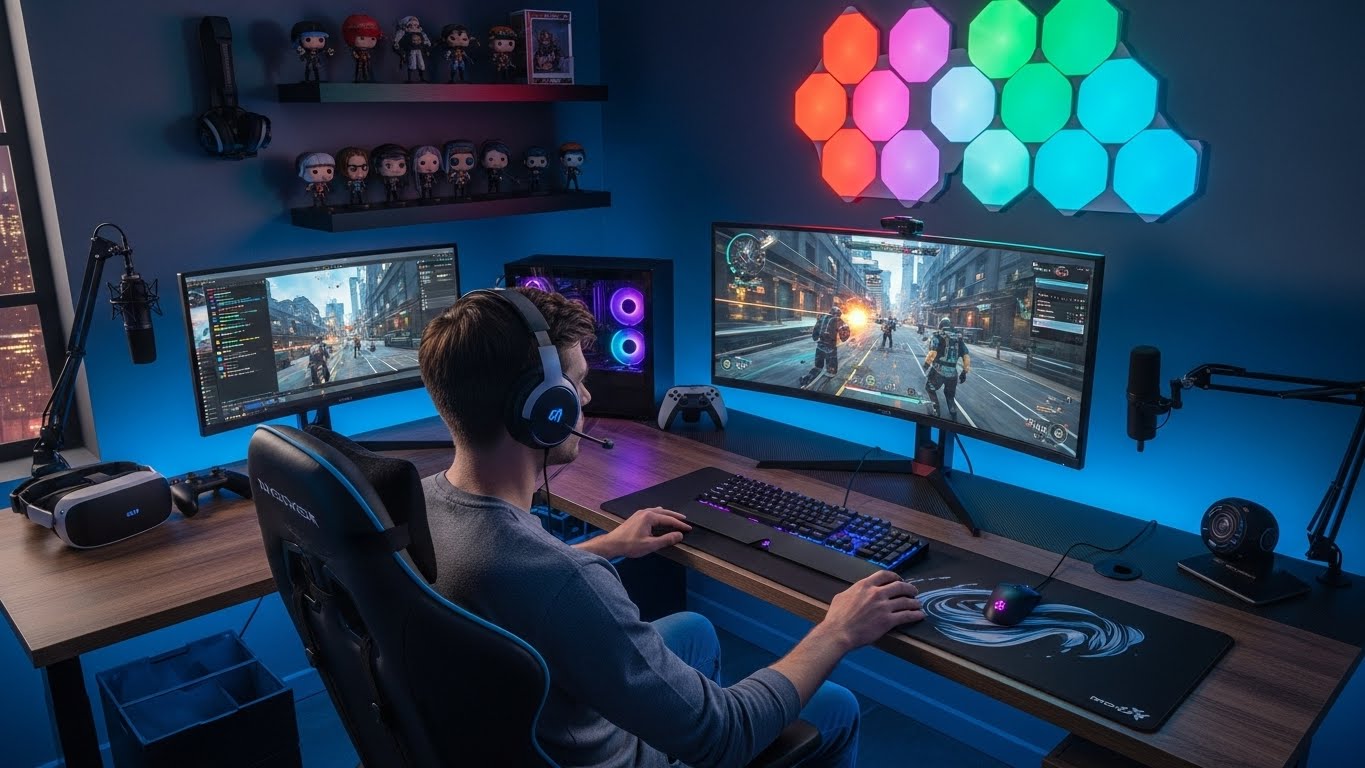Gaming, once seen as a niche hobby, has evolved into a global entertainment industry worth billions of dollars. It has grown from simple arcade games with pixelated graphics to expansive, high-definition worlds that offer immersive experiences, intricate storytelling, and real-time multiplayer interactions. This evolution has been driven by advancements in technology, shifts in culture, and the increasing acceptance of gaming as a mainstream form of entertainment.
In this blog post, we will take a deep dive into the history of gaming, explore the technological innovations that have shaped it, discuss the impact of gaming on society, and speculate on where the gaming industry is headed in the future. Whether you’re a lifelong gamer or someone who’s just begun to explore this vibrant world, this comprehensive look at gaming will provide you with a deeper appreciation for how far gaming has come and where it’s headed.
The Origins of Gaming: A Journey Back to the 1970s
The roots of modern gaming can be traced back to the late 20th century, with the introduction of arcade games and home consoles. In 1972, the world saw the release of Pong, one of the first commercially successful arcade games created by Atari. Pong was a simple two-player game that simulated table tennis with two paddles and a ball, but its simplicity was groundbreaking. This marked the beginning of an entirely new industry—video games.
The Birth of Home Consoles
In the early 1970s, the gaming industry was mostly dominated by arcade machines in public spaces like bars and amusement parks. However, in 1977, the first home console, the Atari 2600, was introduced, allowing players to enjoy games in the comfort of their own homes. The Atari 2600 became a cultural phenomenon and helped to establish gaming as a viable form of home entertainment.
The Atari 2600 featured interchangeable cartridges, allowing players to purchase different games and swap them out on the same system. This innovation was critical to the future of gaming, as it marked the beginning of the software industry within gaming—game developers could now create titles for consoles rather than being limited to a single arcade machine.
The Rise of the Golden Age of Arcade Games
The late 1970s and early 1980s are often referred to as the “Golden Age” of arcade gaming. Iconic games such as Space Invaders, Pac-Man, Donkey Kong, and Asteroids hit the arcade scene during this period. These games introduced new gameplay mechanics, characters, and narratives that captured the public’s imagination.
Pac-Man, for example, became a cultural icon, with its simplistic but addictive gameplay becoming an enduring symbol of the gaming era. The rise of these arcade games also led to the creation of the first professional gaming tournaments, where players competed for high scores and prizes. These competitions would eventually evolve into the professional eSports leagues we know today.
The Technological Revolution: Graphics, Sound, and Processing Power
The early years of gaming were defined by simple graphics, low-resolution displays, and basic sound effects. However, as technology advanced, so did the quality of games. With the advent of more powerful hardware and software, video games evolved from simple pixelated designs into rich, vibrant worlds filled with intricate characters, detailed environments, and complex gameplay.
The Transition to 3D Graphics
In the mid-1990s, gaming underwent a major transformation with the introduction of 3D graphics. Games like Super Mario 64 and Doom showcased the potential of three-dimensional spaces, offering players a sense of immersion that was previously impossible with 2D graphics. This was a breakthrough moment, as 3D environments allowed for more complex gameplay, better character animation, and a greater sense of spatial awareness.
3D graphics were powered by specialized hardware, with companies like Nvidia and ATI leading the charge in producing graphics cards capable of rendering 3D images. This revolution in graphics also led to the rise of first-person shooters and action-adventure games, as developers were now able to create vast, open worlds that players could explore.
Advances in Sound and Music
In addition to visual improvements, advancements in sound technology also played a crucial role in the development of gaming. Early games used simple beeps and boops for sound effects, but as technology progressed, so did the sophistication of in-game audio.
By the mid-1990s, games like Final Fantasy VII and The Legend of Zelda: Ocarina of Time introduced fully orchestrated soundtracks that helped immerse players in the game world. Music became a vital component of storytelling in games, with themes that players could recognize and hum long after the game had ended. The fusion of high-quality sound with stunning visuals made for an even more captivating experience.
The Power of the Internet: Online Gaming Emerges
The late 1990s and early 2000s saw the rise of broadband internet, and with it came the explosion of online gaming. Titles like Warcraft II, StarCraft, and Quake introduced multiplayer modes that allowed players to compete against one another over the internet. The ability to connect with others across the world added an entirely new dimension to gaming, giving birth to the global gaming community.
The concept of massively multiplayer online role-playing games (MMORPGs) became more popular in the 2000s with the release of games like World of Warcraft and EverQuest. These games allowed thousands of players to exist within a persistent, shared world, interacting with one another in real-time. MMORPGs became cultural phenomena, with dedicated fan bases that spent hours upon hours exploring virtual worlds, engaging in quests, and building communities.
The Impact of Gaming on Society: Culture, Community, and Identity
As gaming has evolved, so has its impact on society. What was once seen as an isolated pastime has transformed into a social and cultural phenomenon, shaping everything from fashion to language to social dynamics. Gaming has become a mainstream form of entertainment, influencing not only players but also creators, influencers, and even the economy.
Gaming Communities: Building Connections Across the Globe
One of the most powerful aspects of gaming is the ability to connect with people from all over the world. Online multiplayer games have given rise to vibrant communities where players can come together, form friendships, and collaborate toward common goals. Whether it’s in a competitive League of Legends match or a cooperative Fortnite session, gaming has created spaces where people from different walks of life can unite over a shared passion.
Social platforms like Discord and Twitch have further strengthened these connections, allowing gamers to communicate, stream, and share their experiences. Game developers have embraced the power of community, integrating features that encourage social interaction, such as voice chat, in-game events, and collaborative missions. As a result, gaming has become a social activity, with players bonding over shared experiences, both in and out of the game.
The Rise of Esports: From Hobby to Career
Esports, or competitive gaming, has become one of the fastest-growing sectors within the gaming industry. What was once a casual hobby for players has now become a multi-billion-dollar industry with professional leagues, sponsorships, and global tournaments. Games like Dota 2, Counter-Strike: Global Offensive, and Overwatch have all cultivated massive followings and offered huge cash prizes to top players.
The rise of esports has turned gaming into a viable career path for many players, commentators, and content creators. Esports athletes are now celebrities in their own right, with dedicated fanbases and lucrative endorsement deals. Esports has also led to the creation of gaming academies, where aspiring players can hone their skills and compete at a professional level.
Gaming as Art: Storytelling, Animation, and Immersive Worlds
While early video games focused mostly on gameplay, modern games have become intricate works of art, with deep narratives, stunning visuals, and complex characters. Games like The Last of Us, Red Dead Redemption 2, and The Witcher 3: Wild Hunt have raised the bar for storytelling in gaming, offering narratives that rival those of movies and television shows.
These games have transformed gaming into a form of interactive storytelling, where players actively participate in the plot and make decisions that affect the outcome of the game. The ability to explore vast, detailed worlds and interact with complex characters has made gaming a medium for self-expression, creativity, and emotional engagement.
The growing acceptance of gaming as an art form is reflected in its increasing recognition in mainstream culture. Video games are now showcased in art museums, discussed in academic circles, and studied for their impact on society and culture. The intersection of gaming with other art forms like music, film, and literature has created a new creative ecosystem where ideas can cross-pollinate, and the boundaries between media are becoming increasingly blurred.
The Future of Gaming: Virtual Reality, Cloud Gaming, and AI
The next chapter of gaming promises to be as transformative as the previous ones, with innovations in virtual reality, cloud gaming, and artificial intelligence opening new possibilities for gamers. These technologies will redefine how we play, interact, and experience video games in the coming years.
Virtual Reality: Stepping Inside the Game
Virtual reality (VR) has the potential to revolutionize gaming by offering fully immersive experiences where players are not just controlling a character on a screen but are physically inside the game world. With VR headsets like the Oculus Rift and HTC Vive, players can explore 3D environments, solve puzzles, and interact with characters in a way that was previously only imagined in science fiction.
As VR technology continues to improve, we can expect more games to take advantage of its capabilities, offering rich, fully immersive experiences. Whether it’s exploring an alien planet in a sci-fi game or experiencing a historical event in a historical simulation, VR promises to open up new frontiers for gaming.
Cloud Gaming: Play Anywhere, Anytime
Cloud gaming is another trend that is set to shape the future of gaming. Services like Google Stadia, Xbox Cloud Gaming, and Nvidia GeForce Now are enabling gamers to stream high-quality games directly to their devices without the need for powerful hardware. By using cloud servers to run the games, players can access cutting-edge titles on devices that would otherwise struggle to handle them, such as smartphones or low-end PCs.
This shift towards cloud gaming makes gaming more accessible to a wider audience, as players no longer need to invest in expensive consoles or gaming PCs. It also enables cross-platform play, where players can seamlessly switch between devices without losing progress or performance.
Artificial Intelligence: Smarter, More Dynamic Games
Artificial intelligence (AI) is playing an increasingly important role in gaming, from creating smarter non-playable characters (NPCs) to enhancing procedural generation in open-world games. In the future, AI will allow games to become even more dynamic, with worlds that react to player decisions in real-time.
For example, AI could be used to create more personalized gameplay experiences, where the game adapts to the player’s preferences and skill level. This would result in games that feel more tailored and responsive to each individual player. AI could also lead to more sophisticated storytelling, where the plot evolves based on the player’s choices, making every playthrough unique.
Conclusion: The Unstoppable Growth of Gaming
The world of gaming has undergone incredible changes over the past few decades. From humble beginnings as a niche pastime, it has grown into a global phenomenon that influences nearly every aspect of modern culture. Thanks to technological advancements, gaming is now a form of entertainment, a competitive sport, a creative art, and a social activity, all rolled into one.
As we look to the future, the possibilities for gaming are endless. Virtual reality, cloud gaming, and artificial intelligence are poised to push the boundaries of what’s possible, creating even more immersive and accessible experiences for players around the world. No longer just a hobby, gaming is a cultural force that continues to shape the way we interact with technology and each other.
As the industry continues to grow and evolve, it’s clear that gaming will remain at the forefront of entertainment for generations to come. So whether you’re a casual gamer or a competitive eSports enthusiast, one thing is certain: the best is yet to come.



